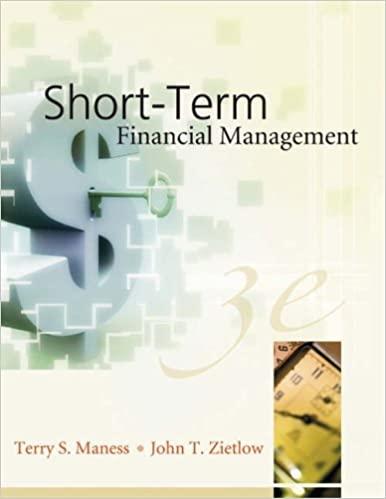Question
JUST NEED HELP WITH F ATTACHED ANSWERS FOR THE REST OF THE QUESTIONS Question 2 As treasurer of Firm A., you are investigating the possible
JUST NEED HELP WITH F ATTACHED ANSWERS FOR THE REST OF THE QUESTIONS
Question 2
As treasurer of Firm A., you are investigating the possible acquisition of Firm B. You have the following data:
-
You estimate that investors currently expect a steady growth of about 6% in Firm B earnings and dividends. Under new management this growth rate would be increased to 8% per year, without any additional capital investment required.
-
Assume that the cost of equity remains unchanged and the Firm A's equity value also remains unchanged.
| Firm A | Firm B | |
| Earnings per share | 8.00 | 2.30 |
| Dividend per share | 3.00 | 1.20 |
| Number of shares | 1,500,000 | 900,000 |
| Stock price | 90 | 30 |
f) There are many tools to acquire companies, discuss the difference between leveraged buyout and
management buyout, provide an example.
(15%)
JUST NEED HELP WITH F ATTACHED ANSWERS FOR THE REST F THE QUESTIONS
A)
Advantages of a Merger
1. Increases market share
When companies merge, the new company gains a bigger market share and gets competitive advantage.
2. Reduces the cost
Companies can buy raw materials in bulk, which can result in cost reductions. The cost of assets are now spread out over a total output, which result reducation of Total cost.
3. Avoids duplication
Some companies producing similar products may merge to avoid duplication and reduce competition. It also results focus on new product.
4. Expands business into new geographic areas
A company seeking to expand its business in a certain geographical area may merge with another similar company operating in the same area to get the business started.
5. Prevents closure of an unprofitable company
Mergers can save a company from going bankrupt and also save many jobs.
Disadvantages of a Merger
1. Raises prices of products
A merger results in reduced competition . Thus, the new company can gain a monopoly and increase the prices of its products.
2. Creates gaps in communication
The companies that have agreed to merge may have different cultures and area. It may result in a gap in communication and affect the performance of the employees.
3. Creates unemployment
In an aggressive merger, a company may opt to eliminate the underperforming employees of the other company. It may result in employees losing their jobs.
B) Use the perpetual growth model of stock valuation to find the appropriate discount rate (r) for the common stock of Company B: P = Dividend1 / (r-g) 30 = 1.20/ (r-0.06) r-0.06 = 1.20/30 =0.04 r= 0.10 = 10% value of the combination (AB) would be the value of Company A before the merger (because Company A value is unchanged by the merger) plus the value of company B after the merger PV(AB) = outstanding Shares A * price + outstanding shares B * D1/(r-g) = 1,500,000*90 + 900,000*1.20/(0.10-0.08) (growth will be 8% after merger given) = 189,000,000 Gain from Acquisition = PV(AB) - PV(A)-PV(B) Now PV(A) = Outstanding Shares A * price and PV(B) = outstanding Shares B * price Gain from Acquisition =189,000,000 - 1,500,000*90-900,000*30 =189,000,000 - 135,000,000 - 27,000,000 =$9,000,000-------------------------------------ANSWER B
C) Cost = Cash Paid - PV(B) = 40* 900,000 - 30*900,000 =$9,000,000-----------ANSWER C
D) After Merger, shares outsatnding of Company A will be 1,500,000 + 900,000/3 = 1,800,000 Hence Share Price will be PV(AB) / After merger share = 189,000,000/1,800,000 = $105 Cost = 900,000/3 * 105 - 900,000 * 30
= $ 4,500,000------------------------------ANSWER D
a) Discuss the advantages and disadvantages of mergers and acquisitions.
b) Using the above data, calculate the gain from the acquisition (explain your calculations).
c) What is the cost of the acquisition if Firm A pays 40 in cash for each share of Firm B?
(25%)
(20%) (10%)
d) What is the cost of the acquisition if Firm A offers one share of Firm A for every
three shares of Firm B? (10%)
e) How would the cost of the cash offer and the share offer alter if the expected growth rate of Firm B were not changed by the merger? (explain your calculations). (20%)
Step by Step Solution
There are 3 Steps involved in it
Step: 1

Get Instant Access to Expert-Tailored Solutions
See step-by-step solutions with expert insights and AI powered tools for academic success
Step: 2

Step: 3

Ace Your Homework with AI
Get the answers you need in no time with our AI-driven, step-by-step assistance
Get Started


